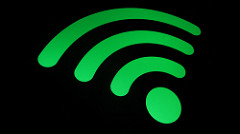 Schools have started getting better about understanding allergies. Some schools have banned peanut butter in an effort to keep kids with peanut allergies safe. The Wi-Fi allergy, however, is still an enigma.
Schools have started getting better about understanding allergies. Some schools have banned peanut butter in an effort to keep kids with peanut allergies safe. The Wi-Fi allergy, however, is still an enigma.
What is an allergy? According to the Mayo Clinic, allergies occur when a person’s immune system reacts to a foreign substance (pollen, bee venom, peanuts) that doesn’t cause a reaction in most people. Symptoms of allergies can range from sneezing to hives to anaphylaxis.
Allergies cannot be cured, but some can be managed. The best way to manage an allergy is for people to avoid the things that they are allergic to. This isn’t always practical advice, and even the best laid plans can sometimes result in an accidental encounter with an allergen.
A family that lives in Massachusetts is suing their son’s school because of the school’s refusal to accommodate his allergy. The boy isn’t allergic to peanuts, or dust, or other common allergens. Instead, the boy is allergic to Wi-Fi.
The parents noticed that their son had certain symptoms during school hours, that would disappear when he was not at school. In 2013, the school installed a stronger internet service. In 2014, the parents noticed their son’s symptoms had started getting worse. Those symptoms included headaches, itchy skin, nosebleeds, dizziness, heart palpitations, and nausea.
The mother concluded that her son had “electromagnetic hypersensitivity” (EHS). She wants the school to switch to Ethernet or to find a way to lower Wi-Fi emissions in order to accommodate her son’s Wi-Fi allergy. She believes EHS is a disability. The school, however, does not appear to be entirely convinced of this. Not very much is known about EHS. It is an enigma.
Martine Richard recently won a court case (in France) in regards to her Wi-Fi allergy. She had to quit her job, and move into a rural barn without electricity, because of her sensitivity to electromagnetic waves. The court ruled that the French government will need to pay her about US$900 a month as disability allowance, for at least three years, due to her Wi-Fi allergy.
The rules regarding disability in the United States might be different from the rules in France. A study about EHS found that “it has proved difficult to show under blind conditions that exposure to EMF can trigger these symptoms.” In other words, the study showed that the so-called Wi-Fi allergy does not actually exist.
The World Health Organization (WHO) notes that “the symptoms are certainly real and can vary widely in their severity”. What is unclear is the exact cause of the symptoms. A person might be reacting to something else in the environment (and not to the Wi-Fi). As such, an allergy to Wi-Fi might not be considered a disability in the United States.
Image by Christiaan Colen on Flickr.
Related Articles at Families.com:
* My Family Tree is Full of Allergies
* Don’t Assume Your Child’s School Understands Allergies

